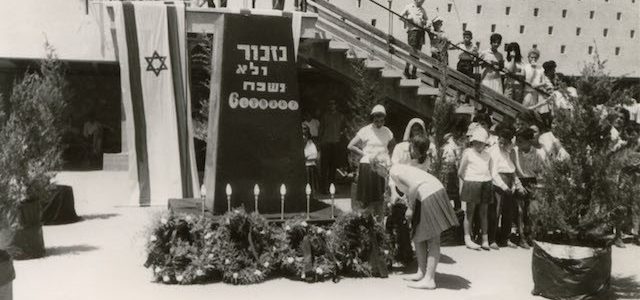
Photo: Yom haShoah ceremony at Kiryat Gat, Israel, 1963. Courtesy www.myjewishlearning.com
The full title of this day for the commemoration of Holocaust victims is Yom haShoah ve-laGevurah, or Day of the Holocaust and Heroism. It falls on the 27th day of Nissan on the Jewish calendar, a week after Passover and a week before Yom haZikaron, Israeli soldiers’ memorial day. If Nasan 27 falls on a day next to the Sabbath (it never falls on the Sabbath), then Yom haShoah is shifted a day away from the Sabbath.
In 2017 Yom haShoah is marked on April 24.
The Knesset, or Israeli parliament, chose this day to remember the Holocaust on April 12, 1951, but it is observed by individuals and Jewish communities world-wide.
In the 1950s Holocaust education focused on the suffering and murder of millions of Jews at the hands of the Nazis, but public opinion polls showed the younger generation of Israeli citizens found it hard to identify with the victims because they believed the Jews of Europe had behaved like “lambs led to the slaughter.” Israeli curricula began to shift to emphasize cases where Jews resisted the Nazis, differentiating “passive resistance,” the ability to preserve human dignity under the most insufferable conditions, and “active resistance,” armed struggle against the Nazis in the ghettos and partisan underground activities.
Siren
Beginning in the 1960s air-raid sirens across the state of Israel were sounded for two minutes to stop traffic for a moment of reflection on the victims. The sirens blast at sunset and again at 11 o’clock in the morning of the same day on the Jewish calendar (the day begins at sunset in the Jewish reckoning of time). All radio and television shows that day are connected in one way or another with the topic of the fate of the Jews in World War II, with many interviews of Holocaust survivors. Even music stations adapt their programming for the mood appropriate to Yom haShoah. Entertainment, drama theaters, movie theaters, bars and other public venues are closed across Israel on this day.
Some Orthodox and ultra-Orthodox rabbis have never approved this day of remembrance, while not rejecting it formally either. At Orthodox synagogues normal religious services are carried on during Yom haShoah. The Orthodox Rabbinate of Israel has suggested making the 10th day of Tevet–the traditional day marking the siege of Jerusalem–into a “common day of kaddish,” where Jews would offer prayers of remembrance and light candles for those who were murdered during the Holocaust. Some ultra-Orthodox rabbis suggested adding piyyutim (religious poetry) written by contemporary rabbis to the Tisha b’Av liturgy, and many communities have adopted that.
In other countries Jews commemorate Yom haShoah both in synagogue and more publicly with their Jewish communities, public community events and educational programs are held. Some congregations move commemoration ceremonies to the nearest Sunday for practical considerations. Many of the events feature testimony by survivors, readings of appropriate texts, performances of songs and screenings of Holocaust films. Some communities chose to focus on the depth of the loss of Jews, reading out the names of the victims and attempting to understand the incomprehensible figure of six million people murdered. Many Jewish schools have special Holocaust education programs on that day and adjacent days.
New Rites
The rituals of Yom haShoah are still being created and differ significantly in different synagogues. There was the attempt to mark the day at home, with the suggestion a special yortsayt (remembrance) candle be lit in every Jewish on this date. Many liturgies (music and texts) have been created especially for the occasion of Yom haShoah. In 1988 Reform movement parties published Six Days of Destruction: Meditations toward Hope. The book was written by Elie Wiesel and Rabbi Albert Friedlander and was supposed to become the “sixth book,” a modern addition to the five books of the Torah (Pentateuch), and to be read out loud on the important holidays. The book contains the testimony of six Holocaust survivors shown in parallel with the six days of the creation of the world in Genesis.
One of the newest projects by rabbis and secular leaders from the US, Canada and Israel is a Megilat haShoah, or Holocaust Scroll, constituted of personal memories of Holocaust victims and written in a biblical style. Hebrew University professor Avigdor Shinan is directing the compilation of this text.
Although there are always new ideas for rituals for marking Yom haShoah and the day is a work in progress, the day is extremely significant to Jews around the world. However it will eventually be marked, all the rites and rituals revolve around a central theme: the main idea is to remember the victims of the Holocaust and to insure it never happens again.
The Holocaust presented an enormous challenge to Judaism itself and raised many questions, including: is it possible to keep the Jewish faith after this tragedy? Where was God? How can one trust in human goodness? After undergoing these recent historical events, is it important to practice Judaism at all? Jewish theologians and secular authors and thinkers have been trying to answer these and other similar questions for decades now. But the fact that Jews still identify as Jews, still practice their religion and observe Yom haShoah is an answer in itself to several of these existential questions.
Material prepared as part of the project “Preparation and Publication of Recommendations for Activities to Fight Anti-Semitism and Romophobia in Lithuania.”
#AtmintisAtsakomybeAteitis
Project supported by:


